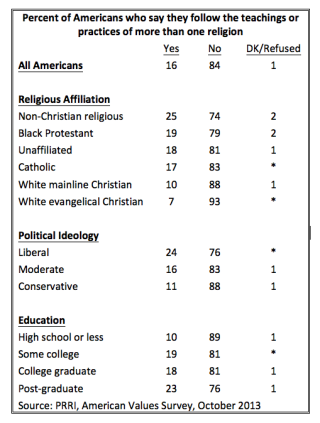It is no secret that the American religious landscape is undergoing tectonic shifts. The rise of the unaffiliated, the growth of non-Christian religions, and the changing face of Catholicism are redefining American religion. 
How are those who practice multiple religions distinct? They are more likely to be liberal and educated, and less likely to be white evangelical Christians. In fact, nearly one-quarter (24 percent) of liberals follow the teachings or practices of more than one religion, compared to 16 percent of moderates and only 11 percent of conservatives.
Americans who have had at least some college are nearly twice as likely to say they follow the teachings or practices of more than one religion compared to those who have a high school degree or less, with 10 percent of high school graduates or less saying they follow the teachings or practices of more than one religion, compared to 18 percent of college graduates and 23 percent of Americans with post-graduate degrees.
There are also differences among religious affiliations. One-quarter (25 percent) of non-Christian religious Americans say they follow the teachings or practices of more than one religion. Nearly one-in-five black Protestants (19 percent) and the religiously unaffiliated (18 percent) say they follow the teachings or practices of more than one religion, in addition to 17 percent of Catholics and 10 percent of white mainline Protestants. White evangelical Protestants are the least likely of religious groups to identify, with only 7 percent saying they practice more than one religion.
Notably, cohabitation is more strongly connected to multiple religion practices than are other relationship categories. One-third of people who are living with their partner say they follow the teachings or practices of more than one religion, compared to 1-in-5 (22 percent) of divorced people, 16 percent of single never married people, 13 percent of married people and 8 percent of widowed Americans.
Interestingly, there is not a difference among age groups in engaging in this practice, with roughly 15 percent of all age groups saying they follow the teachings or practices of more than one religion.
What does it mean to practice multiple religions? One explanation for this trend is the growing popularity of spiritual practices like yoga and meditation, which is primarily associated with Eastern religions. Examples of this include a yoga-practicing Catholic or a mainline Protestant who engages in deep-breathing exercises or other meditative practices. Nearly four-in-ten (39 percent) Americans say they meditate at least once a week. And, nearly one-third of Americans say they explore the spiritual ideas or practices of other religious faiths sometimes (24 percent) or often (8 percent).
While there has been little research done on this question, the increase of religious diversity and interfaith marriages make it likely that more Americans may follow the practices and teachings of more than one religion.